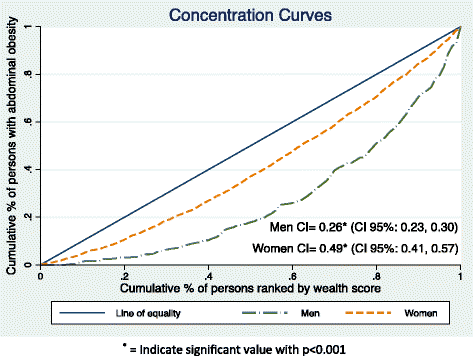Socioeconomic inequality in abdominal obesity among older people in Purworejo District, Central Java, Indonesia - a decomposition analysis approach
- PMID: 29233136
- PMCID: PMC5727959
- DOI: 10.1186/s12939-017-0708-6
Socioeconomic inequality in abdominal obesity among older people in Purworejo District, Central Java, Indonesia - a decomposition analysis approach
Abstract
Background: Obesity has become a global health challenge as its prevalence has increased globally in recent decades. Studies in high-income countries have shown that obesity is more prevalent among the poor. In contrast, obesity is more prevalent among the rich in low- and middle-income countries, hence requiring different focal points to design public health policies in the latter contexts. We examined socioeconomic inequalities in abdominal obesity in Purworejo District, Central Java, Indonesia and identified factors contributing to the inequalities.
Methods: We utilised data from the WHO-INDEPTH Study on global AGEing and adult health (WHO-INDEPTH SAGE) conducted in the Purworejo Health and Demographic Surveillance System (HDSS) in Purworejo District, Indonesia in 2010. The study included 14,235 individuals aged 50 years and older. Inequalities in abdominal obesity across wealth groups were assessed separately for men and women using concentration indexes. Decomposition analysis was conducted to assess the determinants of socioeconomic inequalities in abdominal obesity.
Results: Abdominal obesity was five-fold more prevalent among women than in men (30% vs. 6.1%; p < 0.001). The concentration index (CI) analysis showed that socioeconomic inequalities in abdominal obesity were less prominent among women (CI = 0.26, SE = 0.02, p < 0.001) compared to men (CI = 0.49, SE = 0.04, p < 0.001). Decomposition analysis showed that physical labour was the major determinant of socioeconomic inequalities in abdominal obesity among men, explaining 47% of the inequalities, followed by poor socioeconomic status (31%), ≤ 6 years of education (15%) and current smoking (11%). The three major determinants of socioeconomic inequalities in abdominal obesity among women were poor socio-economic status (48%), physical labour (17%) and no formal education (16%).
Conclusion: Abdominal obesity was more prevalent among older women in a rural Indonesian setting. Socioeconomic inequality in abdominal obesity exists and concentrates more among the rich population in both sexes. The inequality gap is less prominent among women, indicating a trend towards obesity being more common in poor women. Policies to address social determinants of health need to be developed to address the socioeconomic inequality gaps in obesity, with particular focus on addressing the existing burden of obesity among the better-off population group, while preventing the imminent burden of obesity among the worst-off group, particularly among women.
Keywords: Abdominal obesity; Decomposition analysis; Low- and middle-income countries; Older people; Socio-economic inequality.
Conflict of interest statement
Ethics approval and consent to participate
The ethical boards of the Faculty of Medicine, Gadjah Mada University, Indonesia, granted the ethical approval for the study in the Purworejo District. Information about the study was provided to each participant verbally prior to the data collection. The participants were informed that they could withdraw at any stage of the study. All participants gave written informed consent prior to the interview.
Consent for publication
Not applicable
Competing interests
The authors declared no competing interest.
Publisher’s Note
Springer Nature remains neutral with regard to jurisdictional claims in published maps and institutional affiliations.
Figures
Similar articles
-
Waist Circumference and All-Cause Mortality among Older Adults in Rural Indonesia.Int J Environ Res Public Health. 2019 Jan 3;16(1):116. doi: 10.3390/ijerph16010116. Int J Environ Res Public Health. 2019. PMID: 30609857 Free PMC article.
-
Health and quality of life among older rural people in Purworejo District, Indonesia.Glob Health Action. 2010 Sep 27;3. doi: 10.3402/gha.v3i0.2125. Glob Health Action. 2010. PMID: 20959875 Free PMC article.
-
Socioeconomic inequalities in abdominal obesity among Peruvian adults.PLoS One. 2021 Jul 21;16(7):e0254365. doi: 10.1371/journal.pone.0254365. eCollection 2021. PLoS One. 2021. PMID: 34288938 Free PMC article. Clinical Trial.
-
Health inequalities in a middle-income country: a systematic review of the Costa Rican case.Front Public Health. 2024 Aug 21;12:1397576. doi: 10.3389/fpubh.2024.1397576. eCollection 2024. Front Public Health. 2024. PMID: 39234081 Free PMC article.
-
Influence of factors commonly known to be associated with health inequalities on antibiotic use in high-income countries: a systematic scoping review.J Antimicrob Chemother. 2023 Apr 3;78(4):861-870. doi: 10.1093/jac/dkad034. J Antimicrob Chemother. 2023. PMID: 36814075
Cited by
-
Factors associated with body mass index in a cohort of older adults: Structural equation modeling analysis.PLoS One. 2024 Jul 18;19(7):e0305878. doi: 10.1371/journal.pone.0305878. eCollection 2024. PLoS One. 2024. PMID: 39024323 Free PMC article.
-
Trends in prevalence of obesity and its association with hypertension across socioeconomic gradients in rural Yunnan Province, China.BMC Cardiovasc Disord. 2024 Jan 28;24(1):75. doi: 10.1186/s12872-024-03741-1. BMC Cardiovasc Disord. 2024. PMID: 38281972 Free PMC article.
-
Income-related inequities of adult obesity and central obesity in China: evidence from the China Health and Nutrition Survey 1997-2011.BMJ Open. 2020 Oct 30;10(10):e034288. doi: 10.1136/bmjopen-2019-034288. BMJ Open. 2020. PMID: 33127627 Free PMC article.
-
Waist Circumference and All-Cause Mortality among Older Adults in Rural Indonesia.Int J Environ Res Public Health. 2019 Jan 3;16(1):116. doi: 10.3390/ijerph16010116. Int J Environ Res Public Health. 2019. PMID: 30609857 Free PMC article.
-
Anthropometry analysis of nutritional indicators in Indonesian adolescents.J Taibah Univ Med Sci. 2019 Aug 9;14(5):460-465. doi: 10.1016/j.jtumed.2019.07.001. eCollection 2019 Oct. J Taibah Univ Med Sci. 2019. PMID: 31728145 Free PMC article.
References
-
- Korda RJ, Paige E, Yiengprugsawan V, Latz I, Friel S. Income-related inequalities in chronic conditions, physical functioning and psychological distress among older people in Australia: cross-sectional findings from the 45 and up study. BMC Public Health. 2014;14:741. doi: 10.1186/1471-2458-14-741. - DOI - PMC - PubMed
-
- Commission on Social Determinants of Health . Closing the gap in a generation: health equity through action on the social determinants of health. Geneva: World Health Organization; 2008. - PubMed
MeSH terms
Grants and funding
LinkOut - more resources
Full Text Sources
Other Literature Sources
Medical
Miscellaneous



